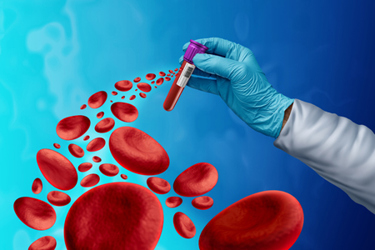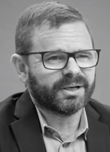The Search For A Chemotherapy-Free Treatment For Patients With Blood Cancer
By Andy Souers, Ph.D., VP and distinguished research fellow, Oncology Discovery Research, AbbVie

Historically, blood cancer treatment options have been limited and oftentimes come with serious short- and long-term side effects. At AbbVie, we wanted to find new ways to target blood cancer cells without destroying healthy cells. It started with our work in the mid-1990s when we were motivated to find a different option for patients with a type of blood cancer called chronic lymphocytic leukemia, or CLL. For patients with CLL, the disease often starts growing slowly, yet it can eventually spread to various parts of the body and become aggressive. It is estimated that nearly 21,000 new cases will be diagnosed in the U.S. this year, making it the most common leukemia among adults.1,2
The CLL Challenge: Increase Effectiveness, Lower Toxicity, And Offer Patients A Treatment-Free Period
Before the discovery of more targeted medicines, people with CLL faced a difficult outlook with limited treatment options, which included chemotherapy, as well as radiation and bone marrow transplants. Moreover, when we started our research in blood cancers, five-year survival rates were almost 20 percent lower — around 50 percent in the early 2000s — than what we are witnessing today.3
One of the goals was to find a better way to treat CLL. Existing treatments at the time could only partially reduce the number of CLL cells in the body, while also eliminating healthy cells. Our vision was to move away from chemotherapy to an enhanced therapeutic approach that restores the body’s ability to fight cancer, resulting in improved efficacy, less toxicity, and more convenience in its delivery. Simply, we wanted to find new ways that would target cancer cells while sparing healthy cells as much as possible.
Key Goal: Reactivate Natural Self-Destruction Of Cancer Cells
Our efforts emphasized a better understanding of cellular biology, i.e., how cancer affects the different processes inside the cell. This led us to apoptosis, a natural process that causes old or damaged cells to die in a controlled way.4 This process helps the body keep a healthy balance of working cells and organs. But in cancer cells, this death process is hijacked. As a result, the cancer can keep growing and even resist treatments like chemotherapy.
We asked ourselves whether we could create a molecule capable of entering cancer cells and reactivating their inherent self-destruction mechanism, which they had evaded. This took us to the B-cell lymphoma 2 (BCL-2) family of proteins, which are cellular factors that aid cancer cell survival by obstructing their natural cell death pathway.5 We theorized that inhibiting the BCL-2 family of proteins within these cancer cells could prompt their natural self-destruction and effectively eradicate leukemia.
The main obstacle was to find a way to begin. At the time we conducted our research, the BCL-2 protein family was seen as an "undruggable" target by the biopharmaceutical industry. One advantage we had was the culture at AbbVie, which encourages the exploration of any research paths that have the potential to transform standards of care for patients.
An Uneven Path: Breakthroughs And Setbacks
We decided to challenge the conventional wisdom that usually governs our scientific endeavors in chemistry and biology. Our quest took several years and included multiple setbacks. However, we did not give up and eventually discovered a molecule that could selectively kill cancer cells by inhibiting BCL-2 and the related protein BCL-XL.
While this was an exciting advance for the research team and the CLL community, we also encountered a new obstacle: through the inhibition of BCL-XL, our molecule led to a reduction in platelets. But these platelets are essential for blood clotting, and when they drop below a certain level, a patient's ability to stop bleeding can be impaired. As a result, they would need to stop treatment until their platelet count was restored.
Our latest challenge led to a new idea: what if we could create a molecule that blocks BCL-2 but not BCL-XL? This would make it possible to treat leukemia patients without reducing platelet count. This hypothesis seemed logical on paper since blood cancers like CLL mainly depend on BCL-2 alone for survival. But as oftentimes is the case in drug research and development, the reality was far from simple. No one had ever discovered such a molecule before. It required starting from scratch to find the key to a lock we couldn’t see.
For a long time, we could not find a way to create a precise key for the lock that was the BCL-2 protein. Finally, after eight months, one of our scientists achieved a breakthrough and generated an X-ray structure that revealed a closer picture of the lock. We noticed subtle differences between the BCL-2 and BCL-XL proteins, which gave us hints on how to design the key for BCL-2. We worked tirelessly for months in the lab to make molecules that would emulate what we saw in the X-ray structure. Finally, we found what we had been searching for all along — a molecule that could selectively inhibit the BCL-2 protein.
The Ultimate Reward: Bringing A New Therapy To Patients
The prototype we discovered only marked the beginning of bringing an actual therapy to patients.
It was an exhilarating journey to discover and develop this therapeutic approach for CLL, but the most meaningful part was when the first patients received this BCL-2-inhibiting medicine in 2011. Since then, this oral treatment, which is designed to be completed in 12 months to allow patients a treatment-free and progression-free period, has become a foundational therapy and has helped many patients with CLL and acute myeloid leukemia. For any researcher, the ultimate dream is to make a difference in the lives of patients, and we remain immensely thankful for this opportunity.
References:
- American Cancer Society. Key Statistics for Chronic Lymphocytic Leukemia. Available at: https://www.cancer.org/cancer/types/chronic-lymphocytic-leukemia/about/key-statistics.html.
- American Cancer Society. What Is Chronic Lymphocytic Leukemia? Available at: https://www.cancer.org/cancer/types/chronic-lymphocytic-leukemia/about/what-is-cll.html.
- National Cancer Institute. Cancer Stat Facts: Leukemia. Available at: https://seer.cancer.gov/statfacts/html/leuks.html.
- National Cancer Institute. NCI Dictionary of Cancer Terms: apoptosis. Available at: https://www.cancer.gov/publications/dictionaries/cancer-terms/def/apoptosis.
- National Cancer Institute. NCI Dictionary of Cancer Terms: BCL2. Available at: https://www.cancer.gov/publications/dictionaries/cancer-terms/def/bcl2.
 About the Author:
About the Author:
Andy Souers, Ph.D., is a distinguished research fellow on the Oncology Discovery Research team at AbbVie. Andy and his team leverage their combined expertise to find new ways to improve the lives of people with cancer. He received his Ph.D. in organic chemistry from the University of California, Berkeley.
